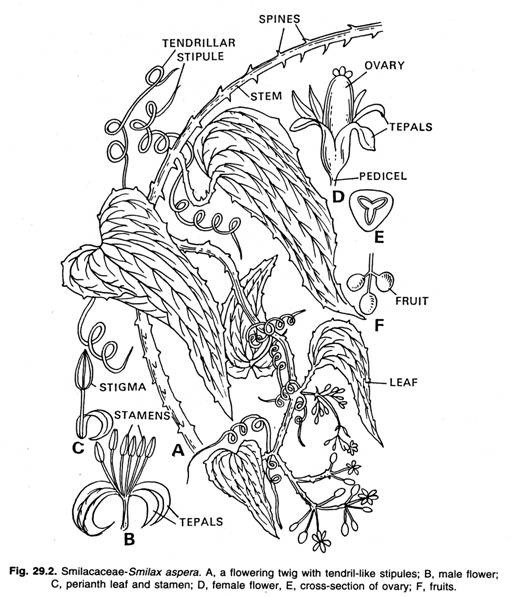ADVERTISEMENTS:
Let us learn about Family – Smilacaceae. After reading this article you will learn about: 1. Explanation of Family—Smilacaceae. 2. Economic Importance of Family—Smilacaceae.
Explanation of Family—Smilacaceae:
Hutchinson has recognised four genera (i.e., Rhipogonum; Smilax; Pseudosmilax and Heterosmilax) in this family. There are about 200 species in the genus Smilax.
Distribution:
ADVERTISEMENTS:
The members of the family are widely distributed in the temperate and tropical regions of the World.
Habit:
The plants are climbing or straggling shrubs. Usually they possess tendril-like petioles and spiny, branched stems. The spines of the stem are very often found in the form of recurved hooks which help in climbing.
Root:
ADVERTISEMENTS:
The adventitious roots arise from the rhizome.
Leaves:
The leaves are small petioled, alternate or opposite, leathery and net veined, i.e., an unusual character in Monocotyledons. In many species the leaves possess two tendril-like stipules at their base.
Inflorescence:
Racemose; generally the flowers are being arranged in auxiliary umbels. Sometimes they are found to be arranged in racemes of spikes.
Flower:
The flowers are small, dioecious, unisexual and rarely hermaphrodite, trimerous and hypogynous.
Perianth:
The perianth consists of six perianth leaves arranged in two whorls of three each. Perianth leaves are generally similar and petaloid. They are either free or rarely united to form a dentate tube.
ADVERTISEMENTS:
Androecium:
In the male flowers it consists of six stamens arranged in two whorls of three each. The filaments are either free or united. The anthers are introse and basifixed. Rudimentary ovary is not found.
Gynoecium:
In female flowers it consists of three carpels which are syncarpous. The ovary is superior, trilocular with axile placentation. One to two ovules are found in each loculus. Styles separate or united. Staminodes are present.
Fruit:
A berry.
Seeds:
The seeds contain a copious fleshy endosperm (i.e., endospermic), and a small embryo.
ADVERTISEMENTS:
Pollination:
It takes place through the agency of insects (i.e., entomophilous).
Economic Importance of Family—Smilacaceae:
The family is of little economic value.
ADVERTISEMENTS:
Some are grown as ornamental plants while others possess medicinal properties.
Few important plants are enlisted below:
1. Smilax prolifera; Verna.-Ram dataun.-This is a climbing prickly shrub, grown as an ornamental. The root is used in dysentery.
2. Smilax zeylanica; Syn. Smilax macrophylla; Verna.-Ramdataun, Jangli aushbah-This is a shrub found in Kumaon, Bihar, Madhya Pradesh and Assam. The young branches and leaves are used as vegetable. The roots are used as substitute for sarsaparilla in the treatment of venereal diseases, applied for rheumatism and also used in bloodless dysentery.



